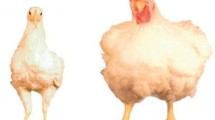Summary
Multiple regression analyses were made of the effect of food composition upon energetic efficiency and existence energy of House Sparrows, Passer domesticus. Protein content of experimental food is the most important of eleven independent variables tested in the prediction of energetic efficiency. Other variables significantly affecting energetic efficiency are fat content of food, ambient temperature, caloric content per gram of experimental food, weight change, geographic location of the capture site of the bird, and season of capture and measurement. Existence energy, a measurement of energy usage under caged conditions, is significantly affected by ambient temperature, fat content of food, weight change, caloric content per gram of food, season and body weight 0.75.
Similar content being viewed by others
References
Barnett, L.B.: Seasonal changes in temperature acclimatization of the House Sparrow, Passer domesticus. Comp. Biochem. Physiol. 33, 559–578 (1970)
Barr, A.J., Goodnight, J.A.: A user's guide to the statistical analysis system. Raleigh, North Carolina State Univ., Student Supply Stores (1972)
Blem, C.R.: Geographic variation in the bioenergetics of the House Sparrow. In: a symposium on the House Sparrow (Passer domesticus) and European Tree Sparrow (P. montanus) in North America (S.C. Kendeigh, chairman), pp. 96–121. Ornithol. Monogr. 14 (1973a)
Blem, C.R.: Laboratory measurements of energy flow through some passerine nestlings. Auk 90, 895–897 (1973b)
Blem, C.R.: Energetics of nestling House Sparrows, Passer domesticus. Comp. Biochem. Physiol. 52A, 305–312 (1975)
Blem, C.R., Blem, L.B.: Density, biomass, and energetics of the bird and small mammal populations of an Illinois deciduous forest. Trans. Ill. Acad. Sci. (in press)
Brenner, F.J.: Energy flow in two breeding populations of Red-winged Blackbirds. Amer. Midl. Nat. 79, 289–310 (1968)
Calder, W.A. II: Consequences of body size for avain energetics. In: Avian energetics (R.A. Paynter, Jr., ed.), pp. 86–144. Pub. Nuttall Ornithol. Club 15 (1974)
Calder, W.A. III, King, J.R.: Thermal and caloric relations of birds. In: Avian biology (D.S. Farner, J.R. King, eds.), Vol. IV, pp. 259–413. New York: Academic Press 1974
Cox, G.W.: The relation of energy requirements of tropical finches to distribution and migration. Ecology 42, 253–266 (1961)
Davis, E.A., Jr.: Seasonal changes in the energy balance of the English Sparrow. Auk 72, 385–411 (1955)
Diehl, B., Myrcha, A.: Bioenergetics of nestling Red-backed Shrikes, Lanius collurio L. Bull. Acad. Pol. Sci. Cl. II 20, 837–843 (1973)
El-Wailly, A.J.: Energy requirements for egg-laying and incubation in the Zebra Finch, Taeniopygia castaniotis. Condor 68, 582–594 (1966)
Gifford, C.E., Odum, E.P.: Bioenergetics of lipid deposition in the Bobolink, a trans-equatorial migrant. Condor 67, 383–403 (1965)
Holmes, R.T., Sturges, F.W.: Annual energy expenditure by the avifauna of a northern hardwoods ecosystem. Oikos 24, 24–29 (1973)
Holmes, R.T., Sturges, F.W.: Bird community dynamics and energetics in a northern hardwoods ecosystem. J. anim. Ecol. 44, 175–200 (1975)
Hopkins, A.D.: Bioclimatics, a science of life and climate relations. U.S. Dept. Agr. Misc. Publ. No. 280 (1938)
Kendeigh, S.C.: Effect of temperature and season on energy recources of the English Sparrow. Auk 66, 113–127 (1949)
Kendeigh, S.C.: Monthly variations in the energy budget of the House Sparrow throughout the year. In: Productivity, population dynamics, and systematics of granivorous birds (S.C. Kendeigh, J. Pinowski, eds.), pp. 17–43. Institute of Ecology, Polish Academy of Science, Warsaw (1972)
Kendeigh, S.C., Blem, C.R.: Metabolic adaptation to local climate in birds. Comp. biochem. Physiol. 48A, 175–187 (1974)
King, J.R.: The bioenergetics of vernal premigratory fat deposition in the White-crowned Sparrow. Condor 63, 128–142 (1961)
King, J.R.: Seasonal allocation of time and energy resources in birds. In: Avian energetics (R.A. Paynter, Jr., ed.), pp. 4–70. Pub. Nuttall Ornithol. Club 15 (1974)
Mantel, N.: Why stepdown procedures in variable selection. Technometrics 12, 621–625 (1970)
Martin, E.W.: The effects of dietary protein on the energy and nitrogen balance of the Tree Sparrow (Spizella arborea arborea). Physiol. Zool. 41, 313–331 (1968)
Olson, J.B.: Effect of temperature and season on the bioenergetics of the eastern Field Sparrow, Spizella pusilla pusilla. Ph. D. thesis, Univ. Illinois (1965)
Owen, R.B., Jr.: The bioenergetics of captive Blue-winged Teal under controlled and outdoor conditions. Condor 72, 153–163 (1970)
Pendergast, B.A., Boag, D.A.: Nutritional aspects of the diets of Spruce Grouse in central Alberta. Condor 73, 437–443 (1971)
Power, D.M.: Evolutionary implications of wing and size variation in the Red-winged Blackbird in relation to geographic and climatic factors: a multiple regression analysis. Sys. Zool. 18, 363–373 (1969)
Seibert, H.C.: Differences between migrant and non-migrant birds on food and water intake at various temperatures and photoperiods. Auk 66, 128–153 (1949)
Snedecor, G.W., Cochran, W.G.: Statistical methods, 6th ed. Iowa: Iowa State Univ. Press 1967
Weiner, J.: Energy requirements of House Sparrows, Passer d. domesticus (L.) in southern Poland. In: Productivity, population dynamics, and systematics of granivorous birds (S.C. Kendeigh, J. Pinowski, eds.), pp. 45–58. Institute of Ecology, Polish Academy of Science, Warsaw (1972)
West, G.C.: Seasonal variation in the energy balance of the Tree Sparrow in relation to migration. Auk 77, 306–329 (1960)
Wiens, J.A., Innis, G.S.: Estimation of energy flow in bird communities: a population bioenergetics model. Ecology 55, 730–746 (1974)
Wiens, J.A., Nussbaum, R.A.: Model estimation of energy flow in northwestern coniferous forest bird communities. Ecology 56, 547–561 (1975)
Willson, M.F., Harmeson, J.C.: Seed preferences and digestive efficiency of cardials and song sparrows. Condor 75, 225–234 (1973)
Zar, J.H.: Using regression techniques for prediction in homeotherm bioenergetics. In: Ecological energetics of homeotherms: a view compatible with ecological modeling (J.A. Gessamam, ed.), pp. 115–133. Logan, Utah: Utah State Univ. Press 1973
Zar, J.H.: Biostatistical analysis. Englewood Cliffs, N.J.: Prentice-Hall 1974
Zimmerman, J.L.: Bioenergetics of the Dickcissel, Spiza americana. Physiol. Zool. 38, 370–389 (1965a)
Zimmerman, J.L.: Digestive efficiency and premigratory obesity in the Dickcissel. Auk 82, 278–278 (1965b)
Author information
Authors and Affiliations
Rights and permissions
About this article
Cite this article
Blem, C.R. Efficiency of energy utilization of the House Sparrow, Passer domesticus . Oecologia 25, 257–264 (1976). https://doi.org/10.1007/BF00345102
Received:
Issue Date:
DOI: https://doi.org/10.1007/BF00345102



